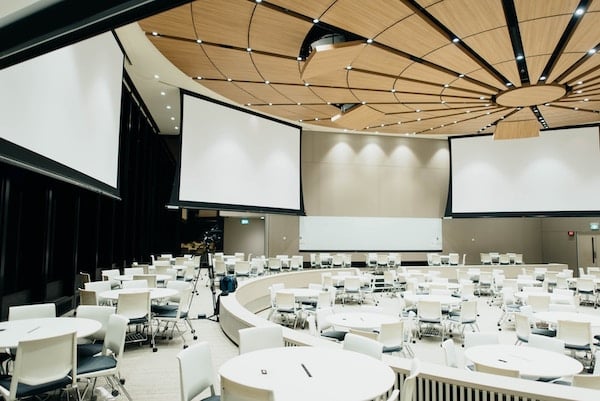Published on
How We Turned Event Planning Into A Major Strategic Asset

Have you wondered how to engage with organizations so you can create deep and lasting partnerships? Consider taking advantage of events and related services to create channels to potential partners. Millions of people attend conferences every year—an audience that needs to hear about what your institution has to offer. Such events give you an already segmented and interested set of prospects. Not only can you reach attendees with your message, you will also discover a source of partnerships for advancing your institution’s priorities in the exhibitors and sponsors that support these events.
This short case study describes the Conference Services Group, which The University of Alabama created to turn events into magnets for potential supporters and partners.
Unlike the teaching and research units of the university, the Conference Services Group does not have subject matter experts to provide content to programs. However, that group has turned what might be a limitation—the lack of subject matter experts—into an asset.
Organized like an event management organization, with staff who coordinate with registration offices, venues, caterers, hotels, marketers and speakers, the Conference Services Group adds an additional dimension to the university by initiating programs with the intent to impact Alabama and its business sectors.
What is the Conference Services Group?
The Conference Services Group at The University of Alabama’s College of Continuing Studies provides turnkey event management for university and non-university organizations. Clients can turn the nuts and bolts of event administration and finance over to the group and focus on turning their own expertise into the content of the event. The group also provides other services, including remote proctored testing and elements of association management. Knowing how the group serves its clients is the basis for thinking about how institutions can turn such a group into a strategic asset.
How Does The Conference Services Group Do Its Job?
Organized in teams of two, with a manager or coordinator and a support staff member, the Conference Services Group combines a consulting approach with its event management operation. The teams seek to understand their clients’ needs and propose solutions. The team members integrate the client into the design and planning process, involving clients as a board of directors for the program, ensuring the design supports the clients’ requirements, and updating the clients throughout the process.
The conference services teams offer multiple tiers of services to their clients, from a very basic online registration service to a full suite of services. The full suite of services can also be broken up into à la carteservices depending on the clients’ internal event management capabilities. Besides registration services, the other services include:
- Content, administrative and financial services
- Marketing
- Facilities management
- Registration services
- On-site conference management
- Post-conference wrap up
The teams tailor the services to the client’s specific requirements. For example, a client may have some in-house event planners that can do certain administrative tasks. Should the client elect to use their event planners for certain tasks, the conference services team can take care of all the other tasks. Most clients, however, find it easiest to turn everything over to the conference services teams.
What do such operational details have to do with the strategic value of a Conference Services Group? Much of the value of the conference services teams comes from their understanding of the institution’s processes and systems, allowing them to find the right levers to use to bring the institution’s resources to bear in support of clients. Such services are the foundation for offering clients additional options. Using the same kinds of services, the Conference Services Group has broadened its portfolio from conferences to:
- Remote proctored testing
- Institutes
- Association management
- Online training
- Summer youth camps
- Cohort training
- Off-campus programs
This variety of services allows the group to serve organizations that might not be interested in conferences at the time. The results of well-planned and executed programs can attract more organizations interested in outreach and programming.
What are the Results of the Conference Services Group’s Work?
The Conference Services Group, as a result, has served multiple sectors and exposed thousands to The University of Alabama’s offerings. Those sectors include:
- Finance
- Government
- Industry
- Research
- Scholarship
- Health
- Human services
- Science
- Education
Prospective partners are impressed by the numbers. Over the course of three years, 53,485 people have attended programs managed by the conference services teams. Long-term partnerships, the goal of engagement strategies, grew out of those programs in the areas of social work, K-12 education, and workforce development. That contact with the university’s capabilities allowed the conference services teams to be catalysts in bringing university and non-university organizations together into new partnerships. For example, the Annual Federal Tax Clinic brings tax professionals together in a conference that also generates funds for accounting scholarships at the university.
Perspective Is The Difference
The Conference Services Group appears to be like other event management units. But what makes them a strategic asset for the College of Continuing Studies and The University of Alabama? The group sees itself as more than a service-provider that puts on events. Instead, it defines itself as a partnership platform so university organizations and non-university organizations can collaborate on programs that impact the state and region. What could be a limitation—the lack of subject matter experts—is an asset because the conference services teams connect the clients, audience and experts through programs. The same teams that execute a conference use the same skills to win and execute contracts to deliver diverse services like remote proctored testing and association management functions.
Some institutions may want to establish their own engagement arms. Here are some key tips to transition from a group providing transactional services (execute the administration and finances for a fee) to a group providing strategic engagement (partnerships with mutually beneficial results that impact the state):
- Imbue the staff with a project management mindset. A project management mindset emphasizes integration of different functions to achieve a common goal.
- Speak the language of the clients. Clients are interested in their own impact and the ROI.
- Encourage an entrepreneurial mindset. Point the staff toward initiating engagement rather than waiting for clients to come knocking. Not everyone has heard of the group’s services.
- Think in terms of engagement. Why stop at putting on the conference the client requested? Develop a relationship that can lead to other programs like training, institutes and outreach for that client organization.
- Shift the perspective from individual programs to portfolios. By looking at the themes different programs might have in common, institutions can group them into a portfolio to demonstrate the institution’s reach and impact. Potential sponsors and donors would be more attracted to large cohesive work than to unrelated individual programs.
Next Steps
Institutions wanting a vehicle for building long-term partnerships should consider redefining their event planning staffs or creating a group that uses event planning skills as a foundation. Starting with individual programs and growing the portfolio, institutions can create an attractive platform of prospective partners that can bloom into support from sponsors and donors. The institution’s teaching programs can also benefit because the expertise on display in programs can attract new graduate and undergraduate students. In an era of economic stress on higher education institutions, such portfolios connect institutions to communities and the workplace, demonstrating their relevance to the constituents they serve.
Author Perspective: Administrator



